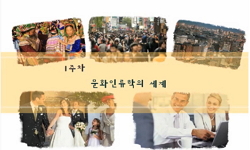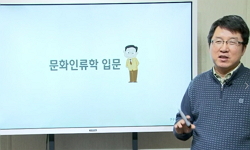‘이두현과 문화인류학이라는 학문의 관계’는 어떠한 정도였을까 하는 질문이 가능하다. 본고를 작성하는 목적은 이 질문에 대한 해답을 풀어보는 과정과 결과를 제시하는것이다. 이두현...
http://chineseinput.net/에서 pinyin(병음)방식으로 중국어를 변환할 수 있습니다.
변환된 중국어를 복사하여 사용하시면 됩니다.
- 中文 을 입력하시려면 zhongwen을 입력하시고 space를누르시면됩니다.
- 北京 을 입력하시려면 beijing을 입력하시고 space를 누르시면 됩니다.

이두현과 문화인류학이라는 학문의 관계: 학사적 초안 = Academic Relationship between Professor Du-Hyun Lee and Cultural Anthropology: A Brief Synopsis in the Realm of History of Anthropology in Korea
한글로보기https://www.riss.kr/link?id=A109644726
-
저자
전경수 (서울대학교)
- 발행기관
- 학술지명
- 권호사항
-
발행연도
2025
-
작성언어
Korean
-
주제어
이두현 ; 문화인류학 ; 이즈미 세이이치 ; 유진 크네즈 ; 샤머니즘 ; Du-Hyun Lee ; History of Anthropology ; IZUMI Seiichi ; Eugene KNEZ ; Shamanism
-
등재정보
KCI등재
-
자료형태
학술저널
-
수록면
169-212(44쪽)
- 제공처
-
0
상세조회 -
0
다운로드
부가정보
국문 초록 (Abstract)
이두현의 학문이 인류학으로 방향을 전환하는 데는 동경대학 교수 이즈미 세이이치(泉 靖一)와의 관계가 큰 영향을 미쳤다. 이즈미는 1965년 한국 방문을 계기로 학문적관심이 샤머니즘으로 집중하였고, 이두현을 연구협력자와 샤머니즘 연구를 위한 동료로서 적극적으로 대우하였다. 이두현은 하나마츠리(花祭)를 관찰하기 위하여 아이치현(愛知縣)의 오쿠미카와(奧三河)를 비롯해서 타네가시마(種子島)의 샤머니즘 현장을 찾아 다닐 수 있었다. 1968년부터 1969년 사이에 이즈미는 이두현을 동경대학 문화인류학연구실 객원교수로서 초빙하여 학생들을 위한 강의를 하도록 주선하였다. 필자와의대화 속에서 이두현은 <花祭>에 대하여 언급하면서 찬사를 그칠 줄 몰랐다. <花祭>는총 1,574페이지에 달하는 방대한 책이기도 하지만, 당대까지 이 세상의 어느 누구도만들어내지 못하였던 치밀한 민속지(ethnography)다. 이두현이 1970년대 이후 추적한작업이 무속의 현장이었고, 그것은 이즈미의 영향이라고 말할 수 있다. 이두현의 무속현장 답사의 족적이 국립문화재연구소의 노력과 지원으로 <이두현 기증 사진집>과 <이두현 기증 무가연구>라는 이름의 자료집으로 탄생하였다.
필자는 이두현 선생의 논문들 중에서도 초분(草墳)에 관한 논문을 심도 있게 정독하였다. 그 논문의 전후로 선생은 자신의 학문적 오리엔테이션을 문화인류학으로 구체적으로 굳혀가고 있었다고 생각되며, 1974년 연말과 1975년 연초에 결정적인 계기를 맞이하여 스스로 전문적으로 공인된 인류학자의 길을 가려는 시도를 하였다. 서울대 종합화와 관련된 일련의 사건에 대하여 필자가 알고 있는 만큼의 사실들을 기록한다. 서울대학교 연구동 6동의 4층에 나란히 교수연구실이 있었고, 설계된 도면에는 “교수 이두현”, “부교수 이광규”, “조교수 한상복”이라고 기록되어 있었다. 이광규 선생은 사범대학 교육학과로부터 사회과학대학 인류학과로 이동할 것을 희망하는 서류를 제출하였고, 마찬가지로 이두현 선생도 사범대학 국어교육과에서 새로 설립되는 사회과학대학인류학과로 이동할 것을 희망하는 서류를 대학본부에 제출하였던 것이다. 그에 따라서작업이 진행되었으며, 필자가 보았던 서울대학교 종합캠퍼스 설계통제실장실의 설계도면에 그러한 결과가 반영되어 있었다. 당시 전대학에서 종합화 과정에 이동을 희망하였던 교수들 중에서 유일하게 보류되었던 사례가 이두현 선생의 경우라고 알고 있다. 증언에 의하면, 이두현은 “미래에는 민속학을 넘어서 인류학을 해야 한다”고 역설하였다
‘이두현과 문화인류학이라는 학문의 관계’는 어떠한 정도였을까 하는 질문이 가능하다. 본고를 작성하는 목적은 이 질문에 대한 해답을 풀어보는 과정과 결과를 제시하는것이다. 이두현은 1958년에 한국문화인류학회의 창립에 참여하였으며, 연극사를 전공하는 과정에서 민속학을 만났고, 1960년대 초까지 학문적 오리엔테이션은 연극사와 민속학에 주된 관심을 갖고 있었다. 그는 1962년부터 문화재전문위원으로 활동하기 시작하였다. 동일 기간 동안에 스미소니언 박물관 인류학부의 큐레이터였던 유진 크네즈(Eugene Knez) 박사로부터 이두현에게 한국의 유물 수집 의뢰가 왔었다.
이두현의 학문이 인류학으로 방향을 전환하는 데는 동경대학 교수 이즈미 세이이치(泉 靖一)와의 관계가 큰 영향을 미쳤다. 이즈미는 1965년 한국 방문을 계기로 학문적관심이 샤머니즘으로 집중하였고, 이두현을 연구협력자와 샤머니즘 연구를 위한 동료로서 적극적으로 대우하였다. 이두현은 하나마츠리(花祭)를 관찰하기 위하여 아이치현(愛知縣)의 오쿠미카와(奧三河)를 비롯해서 타네가시마(種子島)의 샤머니즘 현장을 찾아 다닐 수 있었다. 1968년부터 1969년 사이에 이즈미는 이두현을 동경대학 문화인류학연구실 객원교수로서 초빙하여 학생들을 위한 강의를 하도록 주선하였다. 필자와의대화 속에서 이두현은 <花祭>에 대하여 언급하면서 찬사를 그칠 줄 몰랐다. <花祭>는총 1,574페이지에 달하는 방대한 책이기도 하지만, 당대까지 이 세상의 어느 누구도만들어내지 못하였던 치밀한 민속지(ethnography)다. 이두현이 1970년대 이후 추적한작업이 무속의 현장이었고, 그것은 이즈미의 영향이라고 말할 수 있다. 이두현의 무속현장 답사의 족적이 국립문화재연구소의 노력과 지원으로 <이두현 기증 사진집>과 <이두현 기증 무가연구>라는 이름의 자료집으로 탄생하였다.
필자는 이두현 선생의 논문들 중에서도 초분(草墳)에 관한 논문을 심도 있게 정독하였다. 그 논문의 전후로 선생은 자신의 학문적 오리엔테이션을 문화인류학으로 구체적으로 굳혀가고 있었다고 생각되며, 1974년 연말과 1975년 연초에 결정적인 계기를 맞이하여 스스로 전문적으로 공인된 인류학자의 길을 가려는 시도를 하였다. 서울대 종합화와 관련된 일련의 사건에 대하여 필자가 알고 있는 만큼의 사실들을 기록한다. 서울대학교 연구동 6동의 4층에 나란히 교수연구실이 있었고, 설계된 도면에는 “교수 이두현”, “부교수 이광규”, “조교수 한상복”이라고 기록되어 있었다. 이광규 선생은 사범대학 교육학과로부터 사회과학대학 인류학과로 이동할 것을 희망하는 서류를 제출하였고, 마찬가지로 이두현 선생도 사범대학 국어교육과에서 새로 설립되는 사회과학대학인류학과로 이동할 것을 희망하는 서류를 대학본부에 제출하였던 것이다. 그에 따라서작업이 진행되었으며, 필자가 보았던 서울대학교 종합캠퍼스 설계통제실장실의 설계도면에 그러한 결과가 반영되어 있었다. 당시 전대학에서 종합화 과정에 이동을 희망하였던 교수들 중에서 유일하게 보류되었던 사례가 이두현 선생의 경우라고 알고 있다. 증언에 의하면, 이두현은 “미래에는 민속학을 넘어서 인류학을 해야 한다”고 역설하였다
다국어 초록 (Multilingual Abstract)
Furthermore, the relationship between them grew quickly as a result of the normalization of diplomatic relations between Japan and South Korea in 1965.
Lee’s growing interest in anthropology moved toward the study of shamanism with Izumi Seiichi’s influence in terms of both fieldwork and research papers. I would like to recognize his article titled “Grass Tomb” (1973) as one of his masterpieces, especially in the field of cultural anthropology. In fact, he was seriously engaged in becoming an anthropologist in the due course of his academic career. Also he wanted be identified as an anthropologist in the university system. I intend to figure out why this was, and how he strove to do so.
There was an incident related to the ‘Unifying Program of Seoul National University’ in 1975. Lee made a full-fledged effort to move from the Korean Language department under the Teacher’s College to a newly established department of anthropology under the College of Social Sciences; nevertheless, he finally failed to materialize his lifelong hope in the end. He was impeded by the barrier of university politics, in terms of both the academic organization itself as justification and the interpersonal relationships as a reality. The outcome was that he could not become a “Professor of Anthropology”.
This author interested in the history of anthropology focuses on the academic background and contribution of Professor Lee Du-Hyun (1924-2013). It is very important for us to be candid in doing the history of anthropology. Professor Lee’s academic w...
This author interested in the history of anthropology focuses on the academic background and contribution of Professor Lee Du-Hyun (1924-2013). It is very important for us to be candid in doing the history of anthropology. Professor Lee’s academic works have been clearly acknowledged in the field of the theatrical history through research and education. In 1961 he met Dr. Eugene Knez, an anthropologist at the Smithsonian Institute in Washington D.C., as he was returning from his one-year academic training in the USA. More importantly, there was a good chance for him to move his academic interest into a new field of anthropology through his meeting in 1961 with Izumi Seiichi, an eminent anthropologist at Tokyo University.
Furthermore, the relationship between them grew quickly as a result of the normalization of diplomatic relations between Japan and South Korea in 1965.
Lee’s growing interest in anthropology moved toward the study of shamanism with Izumi Seiichi’s influence in terms of both fieldwork and research papers. I would like to recognize his article titled “Grass Tomb” (1973) as one of his masterpieces, especially in the field of cultural anthropology. In fact, he was seriously engaged in becoming an anthropologist in the due course of his academic career. Also he wanted be identified as an anthropologist in the university system. I intend to figure out why this was, and how he strove to do so.
There was an incident related to the ‘Unifying Program of Seoul National University’ in 1975. Lee made a full-fledged effort to move from the Korean Language department under the Teacher’s College to a newly established department of anthropology under the College of Social Sciences; nevertheless, he finally failed to materialize his lifelong hope in the end. He was impeded by the barrier of university politics, in terms of both the academic organization itself as justification and the interpersonal relationships as a reality. The outcome was that he could not become a “Professor of Anthropology”.
동일학술지(권/호) 다른 논문
-
- 한국문화인류학회
- 이수유
- 2025
- KCI등재
-
- 한국문화인류학회
- 진명숙
- 2025
- KCI등재
-
학자, 의민(宜民) 이두현(李杜鉉) 선생의 주요 저작과 몇 가지 단상
- 한국문화인류학회
- 왕한석
- 2025
- KCI등재
-
- 한국문화인류학회
- 이도정
- 2025
- KCI등재




 KISS
KISS






